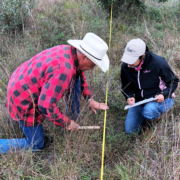Soil Metabolic Pathways
By: Hernan Colmenero
Researchers at Northern Arizona University found evidence that soils use different biochemical pathways to process nutrients, respire, and grow, depending on the type of soil and perhaps other factors. Using the 13C metabolic flux analysis technique, the researchers were able to tag individual carbon atoms in a glucose molecule in much the same way wildlife is caught and tagged to be identified later. They then added the labeled glucose molecule to a marsh soil, an alpine conifer forest soil, and a cool desert grassland soil and found stunning results. Carbon dioxide was produced from different carbon atoms depending on the soil type. This suggests that the soil microbial community is using a different biochemical route to process sugar.
Standard ecology assumes that soil metabolism is a homogenous process, where only the rate of metabolism changes (think hot and humid versus cold and dry). While nobody yet knows why metabolic pathways differ or change, the researchers hypothesize that some pathways may provide protection against oxygen stress.
This means that moving forward, it will be harder to generalize land management results from one soil type to another. “We need to focus on microbial metabolism in soils, and we need more diverse and more powerful tools to do so, no matter how difficult such study might be,” says co-author Michaela Dippold. Only in this way will we be truly able to harness the power of soil biology for regeneration and sustainable health.
For more information, check out these two articles discussing the results of their paper. Let us know what you think on the Soil for Water Forum.
Soil microbes use different pathways to metabolize carbon, EurekaAlert!
Assumptions of a long-term goal on soil microbe carbon use have been lifted, List23



